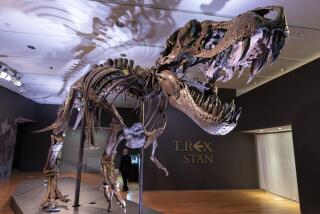Dinosaur Arm Raises Doubt on Function : Fossils: The Montana skeleton is the most complete ever found. It supports the theory that the dinosaur was more predator than scavenger.
- Share via
BOZEMAN, Mont. — The dinosaur Tyrannosaurus rex may have been able to lift half a dozen people in the stubby arms many scientists have dismissed as virtually useless.
That conclusion has been reached by dinosaur hunters at the Museum of the Rockies, based on the only virtually complete T. rex arm ever found. The discovery favors the position of those paleontologists who think the 40-foot-long meat eater was more a predator than a scavenger.
The use of the arms has been one of two great skeletal mysteries of the species. The second is the length of the dinosaur’s tail.
The tyrannosaurus had an arm “a lot more powerful than I expected,” museum curator Jack Horner said. “It could curl something like 400 pounds with one arm.”
Museum staff members Pat Leigge and Bob Harmon and research assistant Matt B. Smith will lead a team of paleontologists into eastern Montana’s white sandstone badlands this month, to be joined later by Horner. They will spend weeks jackhammering out the rest of the 65 million-year-old T. rex skeleton, the seventh and most complete ever found.
It may also be the largest. Its skull is 5 feet, 2 inches long and is still missing the last 4 inches of its nose, which would make it half a foot longer than the largest previous skull, Leigge said.
Smith calculated--conservatively, he said--that the T. rex could lift and stabilize 400 pounds with the biceps on one upper arm. For comparison, he calculated that the museum’s human skeleton could manipulate 41 pounds.
T. rex ‘ s arm is about the same length as man’s, but the forearm is shorter, the two-clawed hand longer and the upper arm bone two or three times as thick, Smith said. He likened the limbs to “grappling hooks.”
“I don’t know what a scavenger is doing with arms like that,” he said. “Maybe for turning over carcasses, but you could do that with your head if you’ve got a powerful neck.
“I think it’s more for securing struggling prey.”
T. rex couldn’t even see its arms, much less reach hand to mouth, so some paleontologists have concluded that the limbs had little importance except possibly helping the animal mate or rise from a prone position.
“Just because it was proportionately small doesn’t mean it was vestigial,” Smith countered. “It means it was very specialized” and probably was used to stabilize rather than capture prey.
“The problem I have with Tyrannosaurus rex is how it catches something,” said Horner, who compared the 6-ton dinosaur to modern carrion-eating hyenas.
“I think that tyrannosaurus was preying on triceratops and duckbills that traveled in gigantic herds. I think they were primarily scavengers, though I think they could take down a sick animal.”
The latest T. rex skeleton, like two turn-of-the-century specimens, was found in the area around the Ft. Peck reservoir on the Missouri River, where fossils litter the ground.
The most common fossils are shellfish, often extinct ammonites. Chips of red and tan sandstone formed from ancient seabeds cover the unpaved roads through the dry hills of scrub juniper, sparse grass and prickly pear.
Amateur fossil hunters Cathy and Tom Wankel of Angela located the latest T. rex during Labor Day weekend 1988, when they noticed a half-inch-wide light brown fossilized bone sticking 2 inches out of dried gumbo mud near the reservoir, Cathy Wankel said. They collected several fragile fossils and brought them to the museum.
“Whereupon I got very excited,” Horner said. “They brought in the arm.”
Horner’s crew went out last fall and uncovered the skull and skeleton, except for the tail.
“It seemed to be complete,” Horner said of the skeleton. “It was beginning to snow, so we decided to take it out this year.”
Horner said he plans to remove the skeleton and surrounding rock in four or five weeks, “if the weather holds.”
The dig site will remain closed to the public, but the skeleton will be taken to the museum and prepared in public view over the next three years. Bones will be molded and cast as they are freed from the sandstone, and the originals will be displayed in the position in which they were found.
Museum researchers will analyze the fossils and rock for information about T. rex ‘ s death, lifestyle and neighbors.
“There’s clues in there that tell us what kind of environment the animal lived in,” said Leigge, who prepares fossils for exhibit. “We can literally walk around in the stream bed that existed 65 million years ago.”
“Dinosauria--they were the most successful group that ever lived on Earth,” he said. “They were the dominant group for over 140 million years. We’ve been around for a few million.”
More to Read
Sign up for Essential California
The most important California stories and recommendations in your inbox every morning.
You may occasionally receive promotional content from the Los Angeles Times.












